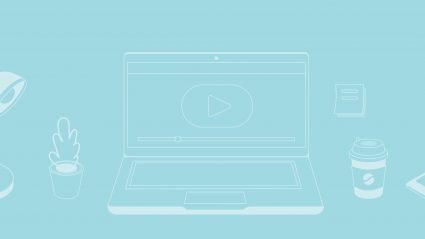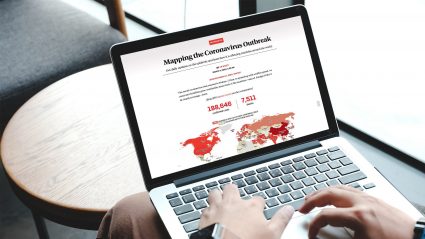We’re all facing a lot through this crisis, both at home and at work. That’s why we brought together some of the smartest minds in digital marketing to discuss all of the changes affecting the digital marketing world — and how we can get through it and even succeed. Mike Mothner, CEO of Wpromote, led the conversation.
WATCH NOW
We hope this will give you a better understanding of what marketers are doing right now — and give you some ideas you can take back to your team today that will make an impact tomorrow.
How has the pandemic affected your business and specifically your digital marketing?
There are many brands that are strong but wounded right now — they’re being affected in various ways by the crisis and related changes in customer behavior, but their core business is still sound.
Courtney Fadjo-Biro, Zenni’s Senior Director of Marketing, discussed how they started making adjustments in the very early stages of the crisis since their factories are located in China and they needed to try to predict potential production delays that would affect customers. As the U.S. situation evolved, Zenni’s internal leadership team took a look at shifts in sales trends and re-prioritized, focusing their marketing more specifically around customer needs.
“This [situation has] afforded us the chance to step back and focus on foundational work around our site, products, and the overall brand,” says Fadjo-Biro. They discovered that it was key for Zenni to pay attention to media storylines – and not in the sitting-at-home-anxiously-searching-Google way we’ve been doing at home. Rather, they took what they learned from their own sources and focused on becoming a valuable avenue for information that resonated with their customers – without taking advantage of the situation. Their new focus led to a change in strategy, with the goal of building customer loyalty and retention.
B2B brands need to zero in on how to make people’s jobs easier.
Christina Bottis, the Chief Marketing Officer at Coyote Logistics, walked us through how things are looking on the B2B side. As a brand that’s centered around keeping business moving (both literally and figuratively), Coyote Logistics has had to alter daily operations, as well as make sure they’re still connecting effectively with the businesses they support.
They started by taking a step back to rediscover why they are doing what they do as a business – something we know many brands and businesses are doing during this time. But the most important priority? Making sure their customers understand what to expect from them while wading in uncharted waters. That means clear, consistent communication — and providing customers with new insights and unique perspectives and exercising the brand’s thought leadership muscle.
They are answering questions that range from how things are getting better to whether there’s light at the end of the tunnel. “Instead of driving to CTAs, we’re driving to content,” Bottis explained. They have positioned Coyote Logistics as an authentic, relatable, and helpful source of information by providing content that reflects both their brand’s values and their deep understanding of and empathy with their customers.
“They rely on us to understand what’s important, so we echo those sentiments.”
How can digital marketers take data about new trends in the marketplace and use those insights to adjust their strategies?
“Despite everything going on, ecommerce spending has doubled since the week of March 9th,” mentions David Dweck, Head of Paid Search for Wpromote. Many brands are focusing on more traditional models of D2C marketing to try and bring people to their websites to make purchases.
Amazon is already prioritizing essential products and people are facing long waits to receive items from other big names like Target and Wal-Mart, which represents a huge potential opportunity for brands to make direct sales and take back the profit margins on their products.
Brands who find their products deprioritized should look to provide a solution to their customers by selling directly to them. Dweck reminds us of the waterfall effect: start at the bottom and focus on what’s working. Remarket to people who are on your site right now and avoid thinking too much about prospects. Focus on your audience and adjust to a broader target later on.
Rachel Bucey, VP of Earned Media at Wpromote, also mentioned some other changes in customer behavior brands should be paying attention to, including the increase of mobile usage. “We have seen a 20% increase since quarantine, so you want to make sure you have a strong mobile conversion.” Make sure to prioritize strengthening your mobile conversion experience.
Bucey adds, “the other trend that we’re seeing, which is pretty interesting in terms of online search behavior and traffic particularly, is a lot of home-bound and anxiety-induced behavior, so lots of people are searching and wanting to consume content that is associated with the fact that they are stuck in their homes, and they’re really nervous about the future and the impact of the pandemic.”
“Educational content is going to ultimately make you more trustworthy for the long term, so that should pay dividends.”
That means your brand should be on the lookout for content and marketing opportunities associated with the new realities of social distancing, shelter-in-place, and self-quarantine. People need activities, products, and services that help them do things in the home or just feel better.
Alcohol brands and direct-to-consumer water filtration systems are doing very well, for example. We’re also seeing positive conversion trends for brands proficient in self-care, fitness, food delivery, home entertainment, and online learning. With people at home, their interests and priorities are shifting – and as a brand, you need to make sure you’re stepping up to the plate and making yourself a brand they can lean on.
That might mean making some changes. “Quick marketing shifts are already proven to be effective,” says Albert Chen, Agency Lead for Google. Many restaurants and retailers, for example, are now offering new curbside pick-up services to maintain sales and even jobs.
It’s key that brands also take this time to reimagine what organic marketing looks like. Companies are taking to Instagram Live to speak to their customers, hoping to make an emotional and meaningful connection. Michelle McKelvey, Partner Manager at Facebook, leaves us with this: “Brands, make a list of the top ten customers you have and pick up the phone and call them, or write an email.”
When we think about the core values of a business, whether it’s a B2B or B2C business, how do you think marketers should adjust messaging to be sensitive to the circumstance, while still driving to their marketing KPIs?
McKelvey shared a success story: Lilly Pulitzer, a brand known for its colorful clothing and patterns, adjusted their messaging to prioritize compassionate connection over conversion. They shared an image of a mom and two daughters with the message: What are some favorite family activities that have filled your homes recently? Nike’s most recent campaign echoes that, communicating that we’re all in this together.
““Build loyalty now, see sales later.”
For Bottis and her team at Coyote Logistics, “right now, it’s all about business continuity. People are just trying to do business, so how can we help business go on right now?” The key here is to not upsell in a time when people are barely managing to make ends meet. Now is the time to ease stress for consumers. “Don’t try and be something you’re not. Authenticity goes far with your current customer base,” says Fadjo-Biro. Stay consistent and reset customer expectations to keep them up-to-date.
How are you thinking about adjusting your own budgets, or if you’re working with other clients, reallocating across channels?
If possible, our experts recommend leaning into the new normal rather than shifting dollars to succeed. For Zenni, many of their ad efforts are spent at sporting events, concerts, and airline magazines. No one wants to cut relationships with other businesses who are also trying to manage during this time. They resolved not to shift dollars as much as possible, but instead shift how they are taking advantage of opportunities and new channels: capitalizing on what you can do. “Leaning into games, socials, and streaming services are key here,” says Fadjo-Biro.
“Make short-term decisions that will help you in the long-term,” says Bucey. Make sure to prioritize your audience’s needs in the now: Bottis advocated for businesses to “shift to areas that are surging, and double-down on getting the foundational stuff to the people who have a need right now.” It’s also worth noting that many brands will choose to pull back on spend, including your competition. Where competitors drive the market, you have the opportunity to seize that space.
You can take it further and really show how your marketing actions are in line with your brands’ values: Coyote Logistics has taken some of their marketing dollars and spent them on putting together care packages for their drivers. There’s a lot you can do to actually give back, a marketing strategy that speaks volumes to millennial and Gen Z customers.
“We really are trying to really put ourselves in the shoes of those people who are working so hard every day to make sure that whatever is normal can continue. So we’re looking how to double down, shift, or give back to those in need.”
When you think about the funnel in today’s environment, what areas do you want to focus more on? Because of the change in customer behavior, are there areas you want to focus less on, or do you look at them all and just apply new KPIs?
Some brands are facing opportunities in the new environment: McKelvey mentions that her personal fitness routine has changed, and Peloton ads are popping up in her various feeds (she’s considering it).
“There are going to be responsive opportunities for clients who have a product or service that people might not have known about before, but is incredibly useful in this type of time,” says Chen. These brands should take the opportunity to really show what they are offering, but also make sure to use tonally appropriate messaging for the situation.
Whether or not your brand is facing a specific product opportunity, Chen reminds us that “advocacy is very important, and great brands market through recessions.” Coronavirus is posing a similar threat to what we’d see in a recession, so as a brand you want to be considerate and create a compassionate narrative across whatever channels you’re in.
Does it make sense to shift what an acceptable KPI is? How are you thinking about what used to be the steady state of KPIs that we measured, and how have those changed in the new reality?
Bottis notes that “KPIs themselves have not changed, but benchmarks will change. What we look at does not change. What will shift is the ratio of pure lead gen compared to brand awareness. The question isn’t what could we lose, rather it’s what could we gain.”
In the end, make sure to stay flexible. Fadjo-Biro says, “this is the time to test into new opportunities with an eye on business goals – placing value on retention and customer expectation and doing right by your base audience.”
Bottom line, we shouldn’t be completely reimagining what KPIs we should be looking at, but instead, adjust where you and your team are spending time and effort. Customers are using their time differently now — and as a brand, you should be too. Again, look to reach out to your clients and customers, check in with your audience, and spend time pulling qualitative data, not just quantitative.
Are there any new strategies you’re currently experimenting with?
McKelvey recommends trying out live functionality: “if you’re a brand, go live on Instagram for some one-to-one interaction.” Going live can help direct-to-consumer brands stay relevant and personable.
Chen says that businesses using Google Ads should look to “invest in automation if you can and check the dynamic of the changing marketplace. For clients who have locations, there’s a lot that can be done with local business services to communicate whether sites are open or not, whether hours have changed, whether there are shopping hours for folks who are immunocompromised or older, so there’s a lot of smaller tactical things that make sense as well for brick and mortar sets.”
Dweck concludes by pushing the idea that there’s no better time for testing new tactics than right now. “Open up the view through windows, conversion windows, and remarketing windows to really try and understand with a better lens what the purchase might look like right now.” Dweck adds that it’s important to keep prospects warm for when things go back to normal. “If that means running a heavy video campaign on Facebook, do it. You’d be able to utilize custom audiences of people who viewed your video, and when you want to market a bit heavier, push them down the funnel.”
“Taking a step back in what you might do from a measurement perspective can lead to significant gains as the world hopefully reverts soon.”
So what’s the main takeaway? Be authentic and focus on your key business functions — and make sure to be proactive in communicating around them. Speak to all audiences, build brand sentiment, capitalize on the moment, and remember what matters most right now: connecting and supporting people during this unprecedented time and remaining true to your brand’s core values.
Interested in watching the full recording or sharing the video with your team? Check out the virtual panel video!







Responses